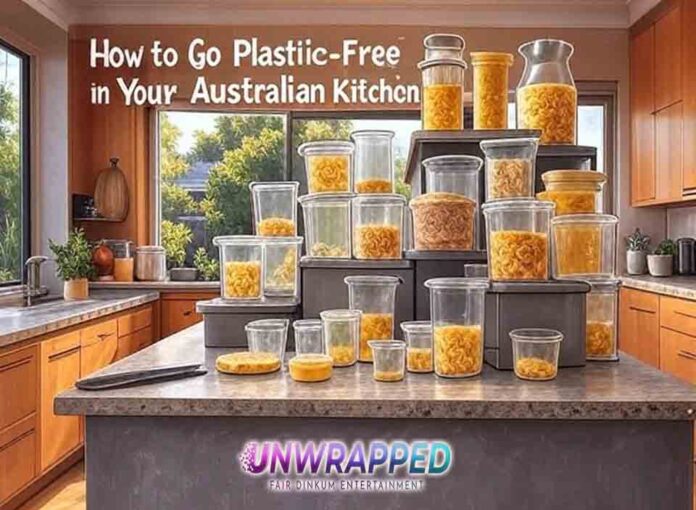The kitchen is often the heart of the home—and unfortunately, also the biggest contributor to household plastic waste. From cling wrap to takeaway containers, plastic sneaks into nearly every aspect of food preparation, storage, and cleaning. Australians alone generate more than 2.5 million tons of plastic waste annually, according to the Australian Government Department of Climate Change, Energy, the Environment and Water. Shockingly, only a fraction of this waste is recycled, with the rest ending up in landfills, waterways, or oceans.
Shifting to a plastic-free kitchen doesn’t just help the environment; it also promotes healthier living. Reducing exposure to microplastics, which are increasingly being found in food and drinking water, is becoming a priority for households across Australia. Going plastic-free may sound challenging, but with the right swaps and mindset, it’s not only achievable—it’s empowering. This guide provides practical, creative, and eco-friendly steps to cut plastic from your kitchen, designed especially for Australians looking to embrace a sustainable lifestyle.
Why Plastic-Free Living Matters
Plastic was designed to last, and that’s precisely the problem. Single-use plastics such as cling film, cutlery, and packaging may serve a purpose for only minutes, yet they linger in the environment for hundreds of years. The Commonwealth Scientific and Industrial Research Organisation (CSIRO) warns that plastic waste poses a significant threat to marine life and biodiversity, with seabirds, turtles, and fish often mistaking it for food.
On a household level, avoiding plastic isn’t just about reducing waste—it’s also about reducing exposure to toxins. Many plastics contain chemicals such as BPA and phthalates, which can leach into food when heated or stored. By choosing plastic-free alternatives, families can make kitchens safer and healthier spaces.
Step 1: Replace Plastic Food Storage Containers
One of the biggest culprits in kitchens is plastic food storage. Switching to glass, stainless steel, or silicone containers is one of the easiest and most effective changes.
Glass containers are microwave- and oven-safe, making them versatile for leftovers.
Stainless steel tins are lightweight and ideal for school lunches or picnics.
Silicone pouches provide a reusable alternative to zip-lock bags, keeping food fresh without the waste.
Retailers across Australia such as Biome and Flora & Fauna now stock sustainable storage options that are designed to last for years.
Step 2: Say Goodbye to Cling Wrap
Australians use an estimated 150,000 kilometres of plastic cling wrap every year, much of which ends up in landfill. Thankfully, there are practical alternatives:
Beeswax wraps: Made from cotton, beeswax, and jojoba oil, these wraps mold around bowls or food.
Silicone lids: Stretchable and reusable, these fit snugly over containers.
Fabric bowl covers: Washable and stylish, they keep food safe without the plastic waste.
Organizations like Sustainable Living Australia highlight cling wrap alternatives as one of the simplest swaps to cut household waste.
See Also: The Ultimate Guide to Extending the Lifespan of Your Plastic Wares
Step 3: Choose Bulk and BYO Shopping
Packaging waste often starts at the supermarket. Opting for bulk food stores or refill stations allows shoppers to bring their own jars and bags, cutting out single-use plastics altogether.
Popular bulk stores, with locations across Australia, let customers purchase everything from pasta to spices without packaging. Bringing your own containers not only reduces waste but also saves money by buying exactly the amount needed.
Step 4: Upgrade Cleaning Supplies
Plastic dishwashing bottles, sponges, and scrubbing pads add up quickly. Plastic-free alternatives include:
Dish soap bars instead of bottled liquid.
Compostable brushes with bamboo handles.
Reusable dish cloths made from natural fibres.
Even mainstream retailers like Biome now stock Australian-made eco-cleaning products designed to replace traditional plastics.
Step 5: Ditch Disposable Cutlery and Plates
For picnics, BBQs, or parties, disposable plastics are common. Instead, Australians are turning to:
Compostable bamboo plates and cutlery.
Reusable stainless steel straws.
Biodegradable paper products certified by organisations like the Forest Stewardship Council (FSC).
Not only are these options eco-friendly, but they also look stylish at gatherings.
Step 6: Switch to Plastic-Free Pantry Staples
Many pantry items come wrapped in unnecessary plastic. Some swaps include:
Buying flour, rice, and sugar in paper bags instead of plastic.
Choosing brands that use glass jars for sauces, condiments, or spreads.
Supporting local producers who package in compostable or recyclable materials.
The Australian Packaging Covenant Organization (APCO) tracks companies making genuine commitments to plastic-free and sustainable packaging. Checking their directory can help households make informed purchases.
Step 7: Compost Food Waste
While not strictly about plastic, food waste often ends up in plastic bags and landfills. Composting with a countertop bin or worm farm reduces waste while creating nutrient-rich soil. Many councils in Australia now provide green waste bins to make composting easier.
The Clean Up Australia initiative emphasizes composting as part of broader waste reduction strategies.
Another Must-Read: Process of Plastic manufacture and its usages – Australia Unwrapped
Step 8: Reusable Grocery and Produce Bags
Plastic shopping bags have already been phased out in most Australian states, but produce bags still remain a problem. Reusable mesh produce bags made from organic cotton or recycled polyester are lightweight, washable, and long-lasting.
Supermarkets such as Woolworths and Coles now encourage customers to bring reusable bags not just for groceries, but for fruits and vegetables as well.
Step 9: Invest in a Water Filter
Australians purchase millions of plastic water bottles annually. A better option is installing a tap water filter or using a jug filter at home. Pairing this with a reusable stainless steel or glass water bottle eliminates the need for single-use plastics altogether.
The Australian Drinking Water Guidelines confirm that tap water in Australia is among the safest globally, making bottled water an unnecessary plastic burden.
Step 10: Get Creative with DIY Solutions
DIY solutions not only reduce plastic but also add a personal touch to kitchen routines. Examples include:
Making your own nut milk in reusable glass jars.
DIY spice mixes stored in recycled bottles.
Homemade cleaning sprays using vinegar, citrus peels, and essential oils.
- Creative reuse helps Australians cut costs while avoiding unnecessary packaging.
Call to Action
Going plastic-free in the kitchen is not about perfection—it’s about progress and conscious choices. Every swap, from ditching cling wrap to composting food waste, makes a difference. Australians are uniquely positioned to lead by example, inspiring others to create homes that are healthier and kinder to the planet.
Start small, celebrate each step, and share your journey with friends and family. Together, households can turn the tide on plastic pollution and move toward a sustainable future.
Conclusion
The kitchen is often the starting point for creating a plastic-free household. By replacing single-use plastics with reusable, compostable, and eco-friendly alternatives, Australians can dramatically reduce their environmental footprint. These small, everyday actions add up to meaningful change, especially when adopted across communities.
Living plastic-free isn’t about sacrifice—it’s about gaining healthier habits, saving money, and protecting Australia’s unique environment. The power lies in simple choices made every day in the heart of the home. A plastic-free kitchen is not just a trend—it’s the future of sustainable living.
People Also Love: The New Era of Eco-Friendly Shopping: Why Choose Non-Woven Bags?










